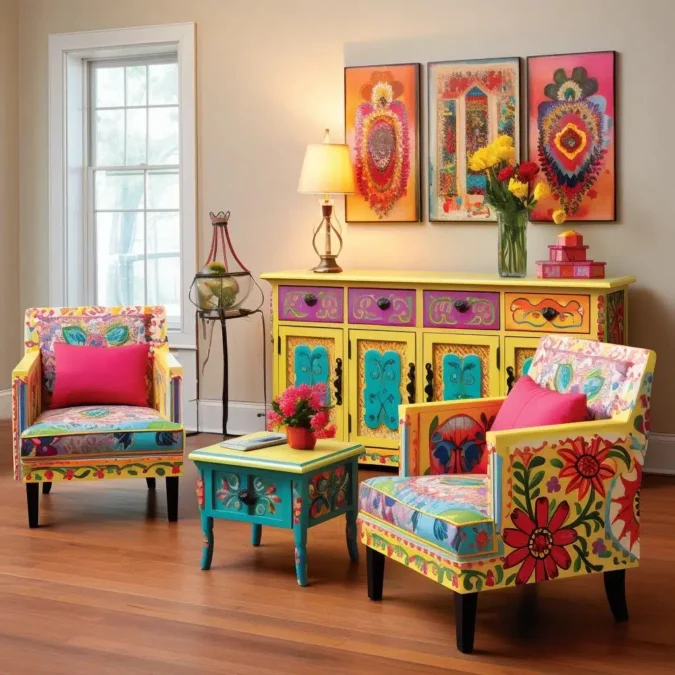Transform Your Home with Furniture Paint: A Complete Guide to Painting Furniture?

Painting furniture is a cost-effective and creative way to revamp your home’s interior design. Whether you’re a seasoned DIY enthusiast or a beginner, furniture paint offers endless possibilities for transforming old, worn-out pieces into stunning decor items that breathe new life into your living space. This guide will walk you through everything you need to know about furniture paint, from choosing the right type of paint to applying the perfect finish.
What is Furniture Paint?
Furniture paint is specialized paint designed for use in wooden, metal, or even plastic furniture. Unlike standard wall paints, furniture paint is formulated to adhere to multiple surfaces, resist wear and tear, and create a durable finish that can withstand daily use.
Furniture paint comes in several types, including:
- Chalk Paint: Known for its matte finish and versatility, chalk paint is ideal for creating a vintage or distressed look.
- Milk Paint: A natural, eco-friendly option that works well for a rustic appearance.
- Acrylic Paint: Offers vibrant colours and a smooth finish, perfect for modern furniture makeovers.
- Spray Paint: Convenient for quick projects and a professional finish on intricate designs.
Benefits of Using Furniture Paint
Using furniture paint is not only practical but also offers several benefits:
- Cost-Effective: Revamping old furniture is much cheaper than buying new pieces.
- Customization: Furniture paint lets you personalize your furniture to match your unique style.
- Sustainability: Repurposing old furniture reduces waste and is environmentally friendly.
- Durability: Modern furniture paints are designed to last, making them ideal for high-traffic areas.
- Versatility: With a wide range of colours and finishes, furniture paint can suit any decor theme.
Preparing Your Furniture for Painting
Preparation is critical to achieving a professional finish. Follow these steps to get your furniture ready for painting:
- Clean the Surface
Before applying furniture paint, clean the surface thoroughly to remove dirt, grease, or grime. Use a mild detergent and a damp cloth for best results.
- Sand the Furniture
Sanding ensures the paint adheres well to the surface. Use medium-grit sandpaper to remove old paint or varnish and fine-grit sandpaper to smooth the surface.
- Fill Any Gaps or Cracks
Use wood filler to repair any cracks, dents, or imperfections in your furniture. Allow the filler to dry completely before sanding it smooth.
- Apply a Primer
A primer helps the paint stick better and creates an even base, mainly if you paint over dark or glossy surfaces. Choose a primer compatible with your furniture paint.
How to Choose the Right Furniture Paint
Choosing the right furniture paint type depends on your project and desired finish. Here are some tips to help you decide:
- Use a rustic look upset for a distressed fit to create for a Rustic Look.
- For a Sleek Modern Look, Opt for acrylic paint or semi-gloss latex paint.
- For Metal Furniture: Use spray paint designed specifically for metal surfaces.
- For Outdoor Furniture: Look for weather-resistant or waterproof furniture paint.
Colour selection is equally important. Neutral shades like white, grey, and beige are timeless, while bold colours like navy blue, emerald green, or mustard yellow can make a statement.
Step-by-Step Guide to Painting Furniture
Follow these steps to paint your furniture like a pro:
- Gather Your Tools and Materials
You’ll need the following:
- Furniture paint
- Primer
- Paintbrushes or rollers
- Sandpaper
- Painter’s tape
- Drop cloth or newspaper
- Sealer or topcoat (optional)
- Protect Surrounding Areas
Place a drop cloth under your furniture to protect the floor from spills and drips. Use painter’s tape to mask off areas you don’t want to paint.
- Apply the Primer
Use a brush or roller to apply a thin, even coat of primer. Allow it to dry completely according to the manufacturer’s instructions.
- Apply Furniture Paint
Stir the paint thoroughly before use. Apply the first coat using long, even strokes. Allow the paint to dry, then lightly sand the surface for a smooth finish. Apply a second coat if needed.
- Seal the Paint
Apply a clear sealer or topcoat for added durability, especially on high-use furniture. This will protect the paint from scratches and stains.
Creative Furniture Painting Ideas
Here are some creative ways to use furniture paint:
- Ombre Effect: Blend two or more colours to create a gradient effect.
- Two-Tone Furniture: Paint the top and bottom sections of furniture in contrasting colours.
- Stencil Designs: Use stencils to add patterns, motifs, or geometric shapes.
- Distressed Look: Sand the edges lightly after painting for a vintage, shabby-chic style.
- Metallic Accents: Add a touch of glam with metallic gold or silver paint on drawer handles or trims.
Common Mistakes to Avoid When Using Furniture Paint
Even experienced DIYers can make mistakes. Avoid these common pitfalls:
- Skipping the Primer: Skipping primer can lead to uneven paint and poor adhesion.
- Using the Wrong Paint: Ensure your chosen paint suits your furniture’s material.
- Rushing the Process: Allow adequate drying time between coats to prevent smudging.
- Ignoring Ventilation: Always paint in a well-ventilated area to avoid inhaling fumes.
- Skipping the Sealer: A sealer is crucial for long-lasting results, especially on frequently used furniture.
Maintaining Painted Furniture
Proper care ensures your painted furniture looks great for years. Here are some tips:
- Clean Regularly: Wipe down painted surfaces with a damp cloth to remove dust and dirt.
- Avoid Harsh Chemicals: Use mild cleaners to avoid damaging the paint.
- Protect from Moisture: Avoid placing painted furniture in damp areas to prevent peeling or warping.
- Use Coasters and Pads: Protect the surface from scratches caused by heavy objects or sharp items.
Conclusion
Furniture paint is a powerful tool for transforming your home on a budget. Whether you want to breathe new life into a family heirloom or customize a thrift-store find, painting furniture allows you to express your creativity while enhancing your living space. By choosing the right type of paint, carefully preparing your furniture, and applying it carefully, you can achieve professional-quality results that stand the test of time.
So, grab your brushes and let furniture paint be your secret weapon for creating a home that truly reflects your style!



